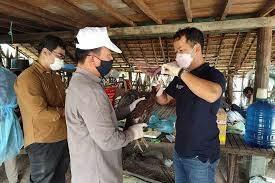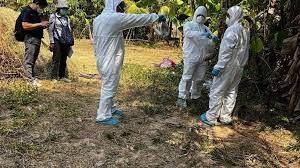 The Ministry of Health of Cambodia reported an apparent cluster comprising one fatality due to H5N1 avian influenza with 1 additional confirmed case. Dr. Youk Sambath, the Secretary of State in the Ministry of Health, dispatched a team to investigate the apparent outbreak. Samples were obtained from residents of villages in the commune of Romlech in Prey Veng Province. Specimens were examined by the Pasteur Institute a reference laboratory in Phnom Penh, the Nation’s capital. Four of eleven suspect cases were symptomatic but all of these cases proved to be AI-negative. Sequencing of virus from the two confirmed cases (deceased daughter and recovered father) identified the H5N1 virus as clade 2.3.2.1c that has circulated in chickens in Cambodia for a number of years. The current panornitic strain present in five continents is classified as clade 2.3.4.4b
The Ministry of Health of Cambodia reported an apparent cluster comprising one fatality due to H5N1 avian influenza with 1 additional confirmed case. Dr. Youk Sambath, the Secretary of State in the Ministry of Health, dispatched a team to investigate the apparent outbreak. Samples were obtained from residents of villages in the commune of Romlech in Prey Veng Province. Specimens were examined by the Pasteur Institute a reference laboratory in Phnom Penh, the Nation’s capital. Four of eleven suspect cases were symptomatic but all of these cases proved to be AI-negative. Sequencing of virus from the two confirmed cases (deceased daughter and recovered father) identified the H5N1 virus as clade 2.3.2.1c that has circulated in chickens in Cambodia for a number of years. The current panornitic strain present in five continents is classified as clade 2.3.4.4b
During recent weeks, reports of H5N1 clade 2.3.4.4b causing deaths in free-living animals have been submitted to the World Organization for Animal Health. The diversity among terrestrial mammals in 2022 includes free-living foxes, skunks, raccoons, bears and cougars in addition to animals in zoo collections. During 2022, cases of marine mammals were identified with seals dying along the coast of Maine, a walrus in Norway and more recently, up to 700 sea lions along the coast of Peru. During late 2022, a mink farm in Spain with 50,000 animals reported H5N1 strain avian influenza, presumably acquired from consuming raw poultry or from contact with free-living birds. Rapid spread within the farm suggested mink-to-mink transmission. The World Health Organization has not released information on the sequencing of the virus from mink to determine whether mutations occurred, facilitating intra-herd transmission. WHO virologists will be evaluating whether mutations in the virus were responsible for any emerging clusters in Asia.
 To date, there has only been one case of transmission of H5N1 fin the U.S. from dead birds or from entrained dust and dander, affecting a worker employed in depopulating a large egg-production complex in the Midwest. Despite many thousands of man-days of exposure among workers during the 2022 epornitic the single asymptomatic and confined case mitigates against direct transmission from infected flocks to humans at this time. Mutations occurring in the current H5N1 virus in Asia could change the present health situation.
To date, there has only been one case of transmission of H5N1 fin the U.S. from dead birds or from entrained dust and dander, affecting a worker employed in depopulating a large egg-production complex in the Midwest. Despite many thousands of man-days of exposure among workers during the 2022 epornitic the single asymptomatic and confined case mitigates against direct transmission from infected flocks to humans at this time. Mutations occurring in the current H5N1 virus in Asia could change the present health situation.
Implications arising from a strain capable of infecting humans even without human-to-human transmission would be of extreme significance to public health authorities worldwide and to the financial viability of the world’s poultry industries.
Pandemics of zoonotic origin have previously emerged in rural areas in Asia as isolated clusters. Villagers who are infected may carry a virus to cities with wet markets serving to amplify and disseminate the pathogen. International air transport has been shown to distribute infection worldwide within a short period. This was evidenced by the spread of SARS and COVID and previous influenza pandemics.
Human-to-human transmission would undoubtedly accelerate the acceptance and deployment of avian influenza vaccine for flocks worldwide. Creating immune populations will be necessary to prevent the emergence of a novel and potentially infectious HPAI strain transmissible to humans. The longer the duration of the current panornitic and the higher the concentration of susceptible birds in large flocks or regions, the greater will be the probability of mutations occurring that may affect humans. The emergence of an H5N1 strain in Asia expressing genes capable of infecting humans is a presumed mechanism by which a pandemic could emerge. China has addressed the problem of H7N9 transmission of HPAI from chickens to consumers patronizing wet markets by vaccinating supply flocks
EGG-NEWS has consistently advocated routine annual influenza vaccination of all employees coming into contact with live poultry. This would reduce the rare probability of a recombination event between human and avian strains, resulting in a potentially pathogenic strain capable of human-to-human transmission.
 The quicker that the U.S. adopts a program of strategic vaccination concentrating on large egg-production complexes in high-risk areas, in addition to broiler breeders and turkeys, the greater will be our level of security. Vaccination will not supplant biosecurity but should reduce the risk of emerging mutants. Obviously there will still be the need to deplete infected flocks showing mortality as a result of infection.
The quicker that the U.S. adopts a program of strategic vaccination concentrating on large egg-production complexes in high-risk areas, in addition to broiler breeders and turkeys, the greater will be our level of security. Vaccination will not supplant biosecurity but should reduce the risk of emerging mutants. Obviously there will still be the need to deplete infected flocks showing mortality as a result of infection.
The USDA-APHIS, our industry associations and health administrators must discard the fallacy that H5N1 strain HPAI is exotic to the U.S. or for that matter, North America. Any disease that requires the depopulation of 55 million commercial poultry, persists for over a year and emerged in 47 states with extension to free-living domestic birds and mammals cannot be regarded as exotic. At the best, H5N1 HPAI is regionally and seasonally endemic.
It is axiomatic that avian influenza is the “Newcastle disease of the 2020s”. This catastrophic disease was successfully contained during the 1960s and suppressed with appropriate vaccination. Until 2020, avian influenza was regarded as an exotic disease that could be eradicated. The extent of the infection over five continents suggests a more realistic approach to control and prevention. The possibility of human infection has created a higher level of concern and the need for rapid action. For years, the USDA-APHIS has been subscribing to the principle of “One-health.” Given the potential of an H5N1 pandemic in addition to the panornitic in progress, now is the time to deploy whatever vaccines are available as an adjunct to traditional control measures.